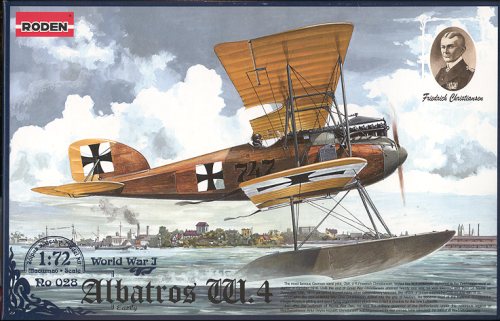
|
KIT: |
Roden 1/72 Albatros W.4 |
|
KIT # |
028 |
|
PRICE: |
$8.98 ($7.96 at Squadron) |
|
DECALS: |
three aircraft |
|
REVIEWER: |
|
|
NOTES: |

|
HISTORY |
Allow me to quote from the Roden website for this one.
|
THE KIT |

The kit is molded in the usual light grey plastic. Detailing is very good and up to Roden's increasingly improving standards. I can only assume that there is an Albatros D.I or D.II in the Roden catalogue as the sprue with the wings on it has quite a bit of flash on it. This is usually indicative of the mold for that section being used a lot and so allowing extra plastic to seep under the worn edges. However, that situation is not found on the other sprues; those being very well formed. There were not any real problems with ejector pin marks, nor with sink marks. I'd highly recommend a fine saw for removing some of the more fragile parts to prevent breaking them.
 Since some of the
sprues are 'multi-version', there are a few parts that are not used on this
particular boxing of the kit. The box states that this is an early version so
undoubtedly Roden will continue with its normal way of doing things and there
will be a late version somewhere down the road.
Since some of the
sprues are 'multi-version', there are a few parts that are not used on this
particular boxing of the kit. The box states that this is an early version so
undoubtedly Roden will continue with its normal way of doing things and there
will be a late version somewhere down the road.
Instructions for Roden kits are very good, offering a parts location, a good painting guide using Humbrol paint references and there is a well done rigging diagram included as well, something that is paramount when doing these early aircraft. Markings are provided for three aircraft, all in wood and linen with grey struts and floats. Actually, the only difference in these planes is the serial number. Apparently in 1916 the idea of bright colors and camouflage wasn't considered as necessary on aircraft. The decals themselves are very nicely printed and appear to be quite thin. There is a full color markings and painting guide on the back of the box, which will be a huge help.
|
CONCLUSIONS |
I'm sure that WWI aircraft fans will be very pleased with this kit. There have been kits of this plane done before by Merlin, Aeroclub and Pegasus. However, those were all short run kits and this one is as close to mainstream as you will find. I think all who build this one will be quite happy with it.
You can find this kit and many others at

If you would like your product reviewed fairly and fairly quickly by a site that has well over 175,000 visitors a month, please contact me or see other details in the Note to Contributors.